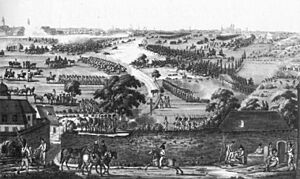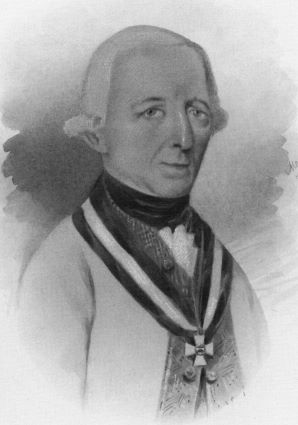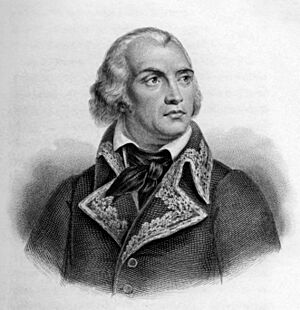Battle of Handschuhsheim facts for kids
Quick facts for kids Battle of Handschuhsheim |
|||||||
|---|---|---|---|---|---|---|---|
| Part of the War of the First Coalition | |||||||
|
|||||||
| Belligerents | |||||||
| Commanders and leaders | |||||||
| Units involved | |||||||
| Strength | |||||||
| 12,000 | 8,000 | ||||||
| Casualties and losses | |||||||
| 1,500, 8 guns | 187 | ||||||
The Battle of Handschuhsheim or Battle of Heidelberg happened on September 24, 1795. It was a fight between the Austrian army and the French army. About 8,000 Austrian soldiers, led by Peter Vitus von Quosdanovich, faced 12,000 French soldiers, led by Georges Joseph Dufour.
The Austrians won a big victory thanks to a powerful cavalry charge. They caused many more losses for the French. This battle was part of the War of the First Coalition, which was a bigger conflict during the French Revolutionary Wars. Handschuhsheim was a village near Heidelberg back then. Today, it is a part of the city of Heidelberg in Germany.
In early 1795, many countries stopped fighting France. Only Austria and Great Britain continued the war. In September, the French government told its armies to attack the Austrian forces along the Rhine River. The French had some early successes, taking important cities and crossing the river. However, when the French tried to capture the Austrian supply base at Heidelberg, they were strongly pushed back at Handschuhsheim.
After this battle, the main Austrian commander, François Sébastien Charles Joseph de Croix, Count of Clerfayt, attacked the French army. He forced them back across the Rhine River. The Austrians then won more battles, making the French armies retreat even further.
Why Did the Battle of Handschuhsheim Happen?
On January 19, 1795, the French army took over Amsterdam. This led to the end of the Dutch Republic and the creation of a new state called the Batavian Republic. The French armies were winning and stood strong on the west side of the Rhine River.
Many countries, like Prussia and Spain, decided to make peace with France. This left only the United Kingdom and Austria still fighting. The French government, called the Directory, faced problems at home. Prices for food and clothes went up, causing riots in Paris.
Meanwhile, French General Jean Baptiste Kléber had captured Maastricht from Austrian and Dutch forces. He then began to blockade Mainz, a strong fortress. However, the Austrians had a large army nearby, led by Feldmarschall François Sébastien Charles Joseph de Croix, Count of Clerfayt and Dagobert Sigmund von Wurmser. This made it hard for the French to fully capture Mainz.
The French government ordered two of its main armies to attack across the Rhine River. General Jean-Charles Pichegru was to attack near Mannheim or Strasbourg. General Jean-Baptiste Jourdan was to cross the river further north near Düsseldorf. Jourdan crossed the Rhine in early September and moved forward. Pichegru, instead of crossing further south, moved north towards Mannheim.
On September 20, 1795, Pichegru and 30,000 French soldiers took Mannheim without a fight. The Bavarian soldiers defending the city surrendered and left. This made the Austrians very angry, but they could not stop it. The loss of Mannheim forced the Austrians to retreat north. The next day, another Bavarian force surrendered Düsseldorf to the French.
The Battle of Handschuhsheim
After taking Mannheim, General Pichegru had a great chance to capture Heidelberg. Heidelberg was a major supply base for the Austrian army. The main Austrian army was too far north to help, and another Austrian army was still gathering.
However, Pichegru made a mistake. He sent only two divisions to capture Heidelberg. Even worse, these French forces were split by the Neckar River. General Jean-Jacques Ambert's division moved on the south side of the river. General Georges Joseph Dufour's division advanced on the north side. Dufour was in charge of all 12,000 French soldiers.
Feldmarschall-Leutnant Peter Vitus von Quosdanovich defended Heidelberg with about 8,000 Austrian troops. He placed some troops at Handschuhsheim on the north bank. Other troops were on the south bank and further south. On September 23, the French pushed back the Austrian defenders. But Quosdanovich quickly brought most of his forces together on the north bank, right against Dufour's division.
The Austrian cavalry was led by Johann von Klenau. As Dufour's French troops moved through open fields, Klenau's horsemen charged them. The Austrians first defeated the French cavalry. Then, they attacked the French foot soldiers. Dufour's division was badly beaten. Many French soldiers managed to cross the river to join Ambert's men.
General Dufour was wounded and captured. Another French general was also wounded. At least 1,000 French soldiers were killed or wounded. The Austrians captured 500 French prisoners and took eight cannons. The Austrian losses were much smaller: 35 killed, 150 wounded, and two missing.
What Happened Next?
General Jourdan wanted the two French armies to join up near Mannheim. But Pichegru refused to work with him. While the French commanders waited for new orders, Jourdan surrounded Mainz. Pichegru used Mannheim as his base.
Soon, the Austrian General Wurmser became strong enough to keep Pichegru busy. This allowed General Clerfayt to attack Jourdan's army. Clerfayt moved around Jourdan's left side, putting the French in a difficult spot. After a defeat on October 11 and 12, Jourdan's army began to retreat north. By October 20, his army had crossed back to the west side of the Rhine River.
On October 18, Wurmser's 17,000 Austrian troops defeated Pichegru's 12,000 French soldiers near Mannheim. The Austrians lost 709 men, while the French lost 1,500. The Austrians also captured 500 soldiers and three cannons. They then surrounded Mannheim.
On October 29, Clerfayt launched a surprise attack near Mainz. In the Battle of Mainz, 27,000 Austrians defeated 33,000 French soldiers. The Austrians had 1,600 losses, but the French lost 4,800 men and many cannons. Clerfayt then moved south to deal with Pichegru's army. The Austrians kept pushing Pichegru's army south until Mannheim was completely cut off. On November 22, the French soldiers defending Mannheim surrendered to Wurmser's Austrian army.
At this time, General Pichegru's loyalty was questioned. He was not happy with the French Revolution and hoped for the return of a king. He had been secretly talking with enemies of France. The French government suspected him but could not act because he was a national hero. Later, in 1797, his secret letters were found, and he was sent away from France. He escaped and went to Great Britain. In 1803, he returned to France but was caught and died in prison.




